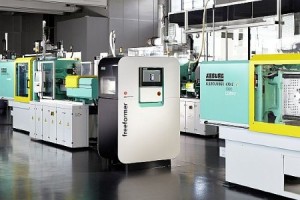In 2015, the “Additive Manufacturing Plaza” will be held for the first time as part of the “Digital Factory”, with exclusive partner Arburg, in a prominent position in Hall 7 of the exhibition centre. This special exhibit deals specifically with the use of additive processes in industrial production. Heinz Gaub, Arburg Managing Director Technology & Engineering, comments: “We are delighted to have the opportunity to present our Freeformer and the patented technology of Arburg Plastic Freeforming in this setting. Firstly, this confirms both the significance of our new industrial system for additive manufacturing and the individualisation of plastic parts as well as the importance of Arburg as a source of expertise in this future-oriented sector.”
Additive manufacturing generates more value from high-volume products
In collaboration with cooperation partners, Arburg demonstrates how, through additive manufacturing, mass-produced articles can be finished with plastics in such a way that manufacturers can generate added value from them. The objective of producing individual plastic parts on an industrial scale is presented by means of a process chain with Industry 4.0 technology. The items under production are “rocker-type light switches” from Gira, the renowned manufacturer of facility management systems.
The technology and expertise in the field of additive manufacturing and the injection moulding of high-volume products, as well as the networking of processes via a host computer system, all originate from Arburg. In addition to Gira (product design and mould construction), other project partners are Trumpf (lettering applied to parts by laser), Fuchs Engineering (quality checks) and Fpt Robotik (Automation).
The entire process chain, “development – production – application”, is demonstrated by means of individual process modules. The process steps commence with product design, followed by the recording of an order and injection moulding production, including lettering applied by laser, plus a quality check. This is followed by the main step of additive part individualisation. The process is rounded off by packaging and the demonstration of comprehensive traceability via a linked host computer.
The process modules in detail
The “Product design” station, which includes a CAD workstation and a Freeformer, shows the production of prototype parts. The process chain for the production of the rocker-type light switches starts at a PC station where the individual orders are recorded and the visitor selects his own symbol/name combination. The light switch basic body is series produced on an Allrounder injection moulding machine. This is part of an automated production cell, which also includes part inspection and code applied by laser. The laser-applied DM code enables the process and quality parameters of each moulded part to be retrieved online – in accordance with the individual part traceability required by Industry 4.0. Here, the Arburg host computer system plays a key role. The Freeformer turns every rocker-type light switch into a unique item by applying the individual symbol/name combination in an additive process with plastics. As the next step, the finished products are placed in “their” packaging in a robotic cell. The packaging is conveyed inline to the process chain and the relevant rocker-type light switch is printed with the symbol/name combination and a QR code, which also enables the product parameters to be retrieved online.
Specialists are at hand to answer questions at every station of the process chain.
A perfect match: “Digital Factory” and Arburg
As a leading international trade fair, the “Digital Factory” provides answers to important questions about tomorrow’s production. The answer lies in the digital harmonisation of different steps in the value-added chain, from development to production, through to the use of innovative products. The “Digital Factory” plays host to many high-ranking decision-makers and innovators from research, development and design. This future-oriented process chain is of interest to both target groups. The example of a rocker-type light switch, which is representative of numerous potential value-added production processes or products, highlights the possibilities of combining injection moulding and additive manufacturing. Basically, many mass-produced parts can be simply individualised by applying these techniques. In this way, we can exploit new market potential for individual components, which were previously not economically viable.



